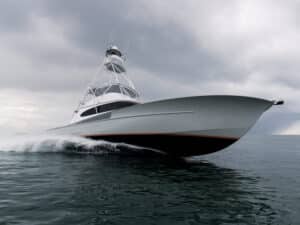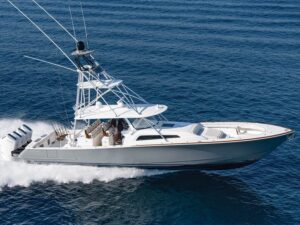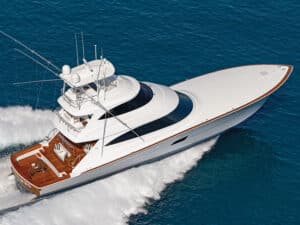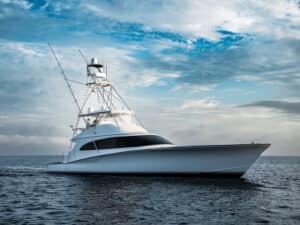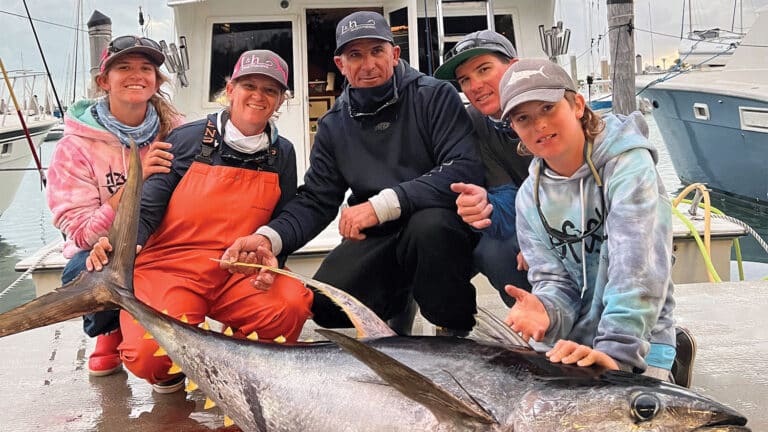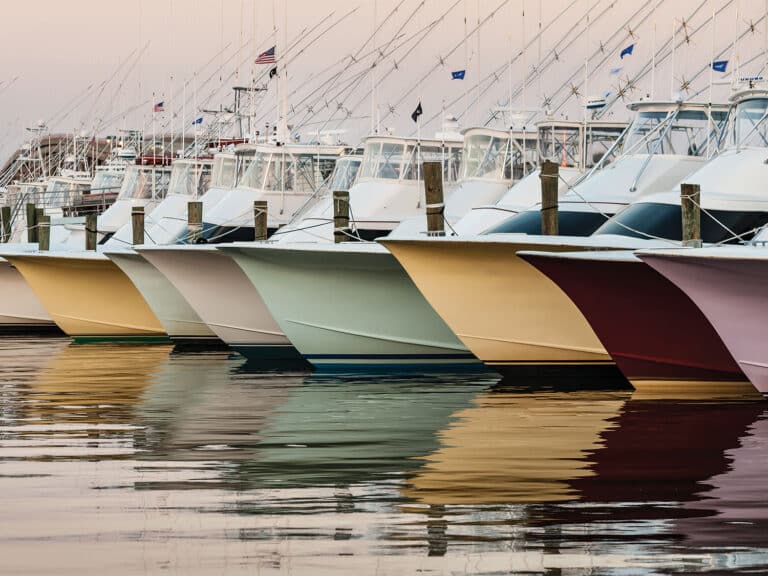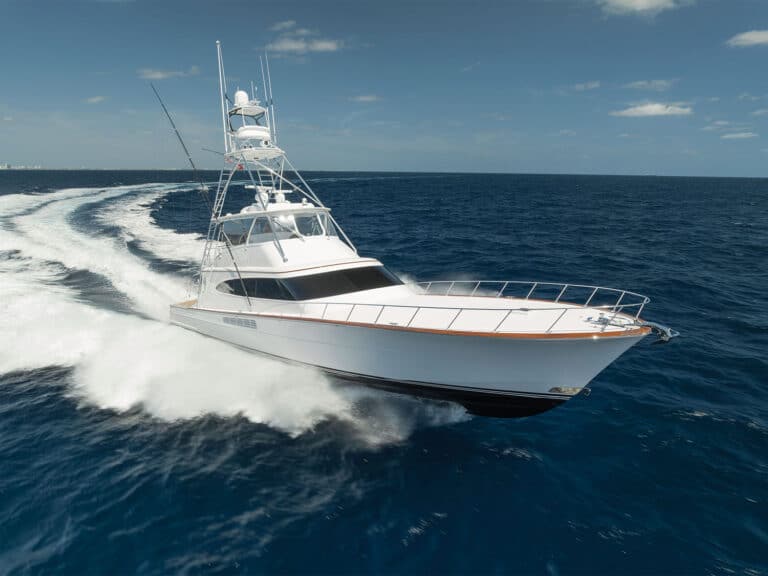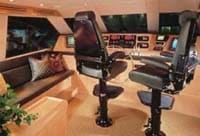
Thanks to a sleek profile, rounded enclosed flybridge and low center of gravity, the brand-new Hatteras 70 stands as one of the most attractive mega-sport-fishermen to hit the water in a long time. While the boat might not be the fastest model this company has ever built, or the biggest, or even the most nimble, what the new 70 does provide is an outstanding combination of all the characteristics that traveling billfishermen appreciate.
As a complete package, the Hatteras 70 is fast enough, big enough and nimble enough to rank as one of the best all-around long-range sport-fishermen available today. Its 18-foot beam affords plentiful storage, spacious accommodations and sleeping arrangements for the owner, several guests and crew. It features Detroit’s new 2000 series engines and a massive 2,000-gallon fuel capacity for a 30-knot cruise and an extended range. And its proven hull design and solid, seaworthy hull respond surprisingly well when faced with the challenge of catching billfish.
Fishability
Not convinced that a 70-foot boat with an 18-foot beam can compete in the offshore tournament circuit? Then talk to Capt. John Bayliss, who took delivery of Hull No. 1 and promptly caught 12 fish to take sixth place among the 295 boats competing at the Ocean City White Marlin Open. He followed that strong showing up with a 20-fish first-place finish at the Pirate’s Cove Billfish Tournament and completed the trifecta with a 15-fish first-place finish in the Mid-Atlantic $500,000’s release division.
“I can understand why some might be skeptical that a boat this big might not be able to maneuver on fish,” says Bayliss, factory captain for Hatteras Yachts. “I kinda felt the same way, but the boat proved me wrong. You may have to run her a little differently than a smaller boat, because the big wheels and high-powered diesels throw back a lot of white water when you move from reverse to forward, but you can catch ’em. We caught a quad, a triple and a couple of doubles, and that can require intricate handling – not what I expected from a boat this large.”
Despite her size and attention to luxury that cruisers and floating condo seekers will appreciate, the Hatteras 70 includes a number of touches that keep her in the serious sport-fisherman category. Foremost among these is her two-tiered, 185-square-foot cockpit. Though perhaps a little intimidating at first sight, the upper “observation deck” actually proves quite useful for a tournament crew. Its primary benefit is the separation it affords. During a fight, angler and crew can operate in a clutter-free environment down below while all non-essential personnel can enjoy the great view from above without being in the way.
A second but no less important benefit: The observation deck provides an elevated platform for watching the baits in comfort out of the hot sun. “I love that deck,” Bayliss says. “It keeps my crew comfortable and alert and helps us spot fish before the strike.”
The layout also offers convenient placement for large freezers, lockers and tackle-storage areas on the lower deck and a huge ice box and Eskimo ice maker up above. Large in-deck fish boxes and an in-transom circulating livewell keep fishing amenities centrally located, and the boat’s 3’1″ of freeboard aft is low enough that a mate can easily reach down to release a fish.
Up Above
One oft-cited criticism of large boats with enclosed flybridges is the lack of visibility a skipper faces when fighting fish. Invariably, boats of this nature include aft-mounted control stations to counteract this problem, but few really provide the unobstructed view and useful layout that an open bridge affords. In fact, on some boats these aft consoles appear as last-minute additions rather than a critical ingredient in the boat’s fishing success.
While most tournament skippers will still prefer the open bridge layout (which Hatteras does offer on this model), the aft station on the Hatteras 70’s enclosed bridge stands as a notable exception in the areas of visibility and functionality. Not only is the control station ideally positioned for a complete view of the cockpit, it sits underneath a large, molded-in overhang that provides a good bit of shade for the skipper. It features single-lever controls mounted on a pod helm, station-active buttons for DDEC’s trolling valves and low-idle modes, as well as space for flush-mounting a full electronics package, including depth finder, GPS, radio and temperature gauge. A cushioned seat to starboard, complete with handrails, allows for comfortable guest seating, and the center-mounted tower ladder is both safe and out of the way. Further, access to the bridge via the cockpit ladder can be controlled by a hatch that latches tight either open or closed.
Inside the enclosed bridge are the luxurious appointments you would expect, including air conditioning, plenty of guest seating, vast space for flush-mounted electronics (with easy access to all wiring and electronics installations) and two fully adjustable helm chairs. Forward visibility is good, though moving the electronics console forward and down a bit would make it even better. Current models do not offer the popular circular staircase leading down to the salon, though future versions of the 70 may include that option.
Down Below
Inside the salon of the Hatteras 70, you’ll find the spacious layout and luxurious appointments for which Hatteras is famous. But you’ll also find a couple of nifty touches that set this layout apart from the mundane. The first of these is the master stateroom, a full-beam beauty that includes a king-size berth amidships, private head with shower, built-in dressers and nightstands, and large cedar-lined lockers. (A crew’s quarters to port, twin bunks that easily convert into a double to starboard, and a queen berth in the forepeak complete the four-stateroom, four-head arrangement.)
A second point of interest in the 70’s layout is the unusual spot the builder chose to locate the boat’s air-conditioning and water pumps. Rather than house them inside the engine room, Hatteras placed them inside the bulkheads on both the port and starboard side of the stairway leading down to the staterooms. Insulated for sound and heat, these pump rooms are easy to access and allow the company to keep the 70’s engine room clutter-free.
The removal of pumps from the engine room creates surprisingly open working spaces both inboard and outboard of the large V-16 Detroit 2000 Series engines, though a fuel tank amidships does rob the forward half of the engine room of some headroom. Still, the entire compartment is captain-friendly, with systems well organized and easily accessed.
For more information, contact Hatteras Yachts, 110 N. Glenburnie Road, New Bern, NC 28560; 252-633-3101.
